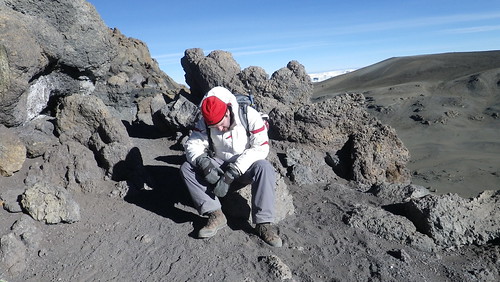
First of all, Stephanie is correct. Mt. Whitney of California is indeed the highest peak in the lower 48. My previous week's post stands corrected. Thanks Steph!
I hope everyone had a great Memorial Day celebrating freedom. Because of this, this week's post will be short. I promise to make up in future weeks.
Today, we are going to talk about drugs. I know most of you are interested in the altitude stuff, but first, I would like to talk about other shots, and specifically malaria drugs.
Going to tropical Africa requires shots. Lots of shots. The Center for Disease Control (CDC) recommends the following for Americans traveling to Tanzania:
Everyone should have the routine ones regardless, obviously.
Hepatitis was the big one for me. While I thought I had been vaccinated, to be safe, I did the three-part where you take two shots (for both Hepatitis A&B) within a month of each other prior to the trip, and then the booster six months after.
Not much to be said here.
I went to a local travel clinic to get these shots, and the specialist said I probably wouldn't need this one, unless I planned on going to India (it's in the water?) within the next five years. Since that was a possibility, I took it. You can get some of these from your doctor, but they generally don't have the more obscure ones available, so you have to go back for multiple appointments. Generally, travel clinics do not take insurance, but you can submit what you pay to your insurance company and get some of it reimbursed. For me, I got about half of my money back.
The CDC says you actually don't need this one since Tanzania only really blocks people coming from yellow fever countries, I decided not to chance it and just took it. William was trying to be extremely economical, and called around to about a dozen pharmacies. Most of them did not have it on hand (for obvious reasons), and if they ordered it, they wanted him to buy the whole bottle, which would have cost a couple hundred. Luckily, the last one he tried was willing to just provide him with one dose.
The specialist said this wouldn't really be necessary unless I planned to go into caves and have bats bite me. While perhaps one may have been, safe to say both were not on the itinerary, so I passed.
Now, all these shots are listed on a yellow multi-page card that looks like this:
Unfortunately, for two other diseases, there are no preventative shots. The first is dengue fever. There is nothing you can do for dengue fever, whether it is prevention or treatment, unless you consider avoiding getting bitten by mosquitoes prevention. Supposedly, this isn't super difficult because these particular mosquitoes are big, slow, and red. If you get it, you just have to go to the hospital, drink a lot of fluids, take something for the pain, and wait it out, usually a week. My friend Tim got it in Colombia and was out for two weeks. But he's back now at full strength. Go Tim!
The second is the infamous malaria. Fortunately for malaria, there is prevention. Unfortunately, they are in the form of pills that require a disciplined daily regime - you have to take them at the same time of day beginning a few days before you enter the infected zone (to build up the drug in your system), and then keep taking them for a week after you leave the zone (to make sure all of any malaria virus you may have contracted has exited your system). It's easiest to plan to take them with a meal. Most doctors used to prescribe Lariam, but too many people got night terrors with them, so most people now take Malarone. Apparently, Malarone also has some night terror side effects, however, as a girl we met in Ethiopia who had spent two years in Tanzania in the Peace Corps said she stopped taking them after a few months because it wasn't worth the side effects, and she said she never even came close to getting malaria. So, there ya go.
And now for the Big Kahuna: altitude sickness.
- Q: What is altitude sickness?
- A: It's a bunch of things, but the most common symptoms are shortness of breath, nausea, headaches, fatigue, dementia, and the like at high altitudes.
- Q: How high are we talking?
- A: Can be any amount of altitude, but generally it really starts showing up at around 8,000 feet.
- Q: What causes it?
- A: A bunch of things, but mostly because the air is thinner at higher altitudes, your blood has trouble carrying enough oxygen to the brain. The level of oxygen at the top of Kilimanjaro is about 1/2 that at sea level.
- Q: Who gets it?
- A: There is really no way of knowing at sea level who is affected. You have to see for yourself.
- Q: I am a super athlete that runs amazing marathon times. Will it affect me?
- A: Yes. Athleticism is surprisingly decoupled with altitude sickness.
- Q: No really. I am an awesome athlete. I will be okay, right?
- A: See above, and get over yourself.
- Q: Is there anything I can do to mitigate it in preparation before the trip?
- A: Sort of. You can go train at higher altitudes, which your body may remember on future treks. At the very least, you can see how you feel at those altitudes ahead of time so you won't be surprised when it happens.
- Q: I don't have the time or money to go somewhere with high altitudes. What if I do aerobic training, like hiking up and down 3,000 foot elevation changes, albeit starting at way lower altitudes?
- A: Minimal. Your lung capacity is just one small component in determining whether you get altitude sickness.
- Q: Why won't you work with me here! There has to be something I can do to prepare my body better before the trek! This is the 21st century! I will not accept no for an answer!
- A: For whatever reason, God made us with specific altitude abilities. Deal with it.
Which brings us to the most important question.
- What can I do on the trek to minimize altitude sickness?
The first and most effective thing you can do is increase altitude as slowly as possible, particularly above 8,000 feet. The more you let your body adjust, the greater your chance of getting to the next higher altitude without suffering side effects. Now, of course, this is easier said than done. After all, on Kilimanjaro, time is literally money, as every extra day on the mountain is $100 in park fees, and another $100 in guide/porter/supply fees. So, as a general rule of thumb, people who have gone suggest doing no more than 2,000 feet per day, maximize the number of days spent over 11,000 feet, and sleep about 500 feet under the highest point you reach on a particular day.
Just in case, however, medical science has introduced a little bit of a helper with the drug Diamox. It does a lot of things, but in essence, it's a blood thinner that also increases the capacity of your red blood cells to hold oxygen - in other words, more bang for your hemoglobin. Now, there is a little bit of a dilemma of how you take the Diamox. Most people take it preventatively by taking two a day for the entire trek, hoping that it boosts your system somewhat for the entire journey. However, there is a risk in this, in that if despite taking Diamox, you still get sick, taking additional Diamox will not have any effect. Because of this, some people take it as treatment, as in they don't take it until they get sick. There is no right answer. Pick your poison.
Okay, back to the trek. The trek this day was to First Cave Camp about 4 miles, 3,000 feet (I know, I know, it's more than the 2,000 feet limit, but we end the day below 10,000 feet), and took about 3 hours.

The first hour, we went through farmland. The farms were mostly growing maize and trees, with the trees being placed in reasonably straight rows with no underbrush.

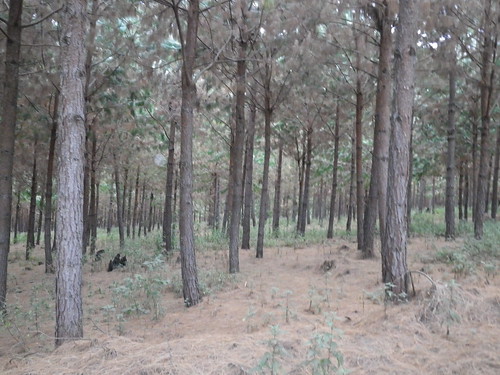
After that, we entered the jungle.
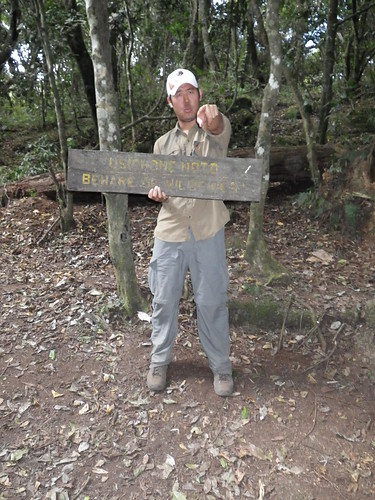
Only you... can prevent forest fires.
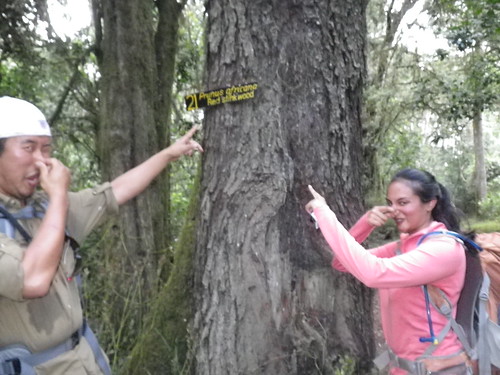
It didn't really stink.
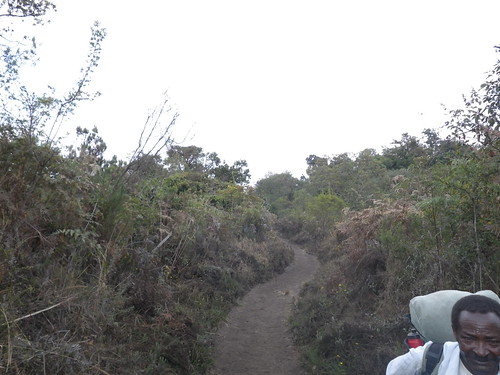
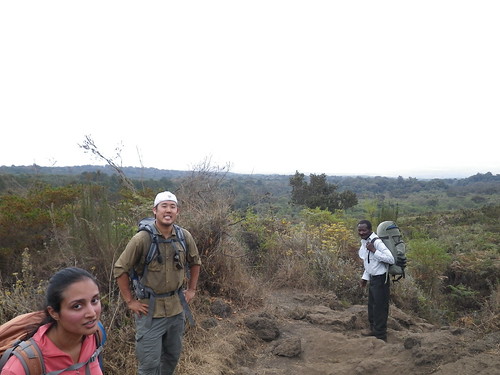
After another hour, we quickly left the jungle to enter the moorland. This is where we would spend the next three days.
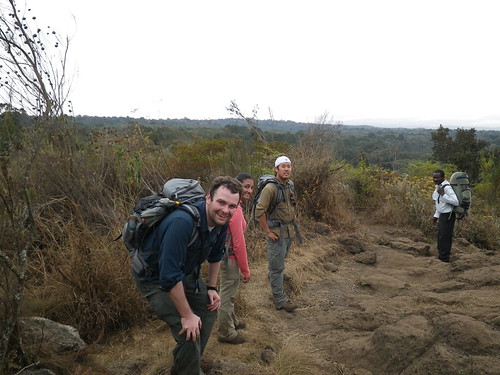
I don't know why William is squatting.

The first of many crazy trees.

The first running water we run across. In hindsight, it was stupid to be there because of the mosquitoes. It is also from streams like these where we would get our drinking water. Yes DRINKING WATER. More on that in future posts.
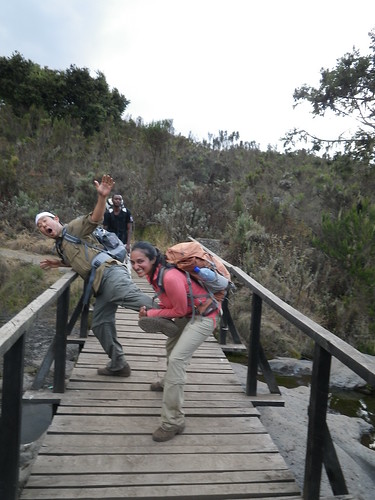
And we end this week with a "bridgehanger" (cue bad puns). Until next time...


No comments:
Post a Comment